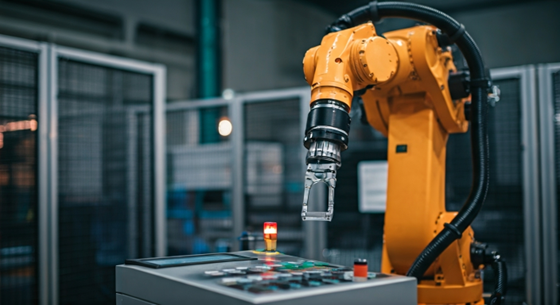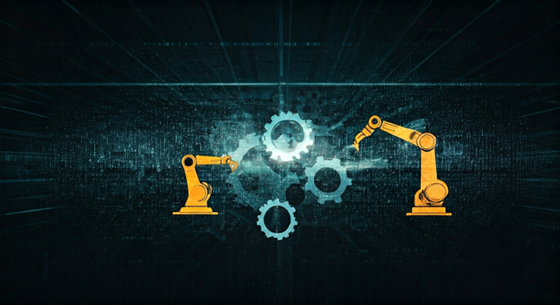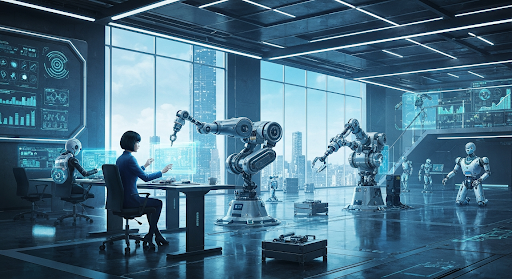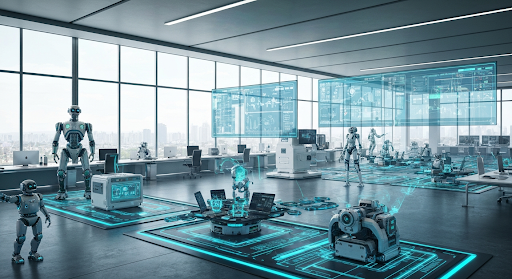Beginner’s Guide to Automatic Manufacturing: Key Concepts
Key Highlights
- Automatic manufacturing uses industrial robots and automated systems to make production processes run faster and smoother. These tools help cut down on manual labor and make work easier.
- You can find different types of automation, like programmable automation and flexible automation. Each type is made for different needs in the factory.
- Using automation helps raise production rates, makes product quality better, and lowers labor costs. It also helps cut down on human error while making things.
- With tools such as artificial intelligence, machine learning, and control systems, manufacturing plants become smarter. These tools help them use data to work better.
- Automation technology
- changes how things are done from assembly lines
- to inspection systems
- . It makes work smoother on the factory floor
- whether the industry is big or small.
Introduction
Automation has changed how many industries work. The old way had a lot of slow steps that used a lot of people. Now, using automatic manufacturing and industrial automation, companies can make their production processes faster, more accurate, and have fewer mistakes. With automated systems, many factories have started to use robotics, artificial intelligence, and machine tools. These new things help people get more done in less time and do the job better.
This guide will help you learn about automatic manufacturing. You will find out about its basic ideas, as well as how it is used today.
In the next part, you will get to know the basics of automatic manufacturing.
Understanding Automatic Manufacturing: The Essentials

Automatic manufacturing is at the center of today’s progress in industry. It brings together automated systems, automation technology, and some manual labor to make goods and parts quickly and well. Old manufacturing processes are changing, and now more firms use machines that work on their own. This way, work keeps going smoothly, and items often meet higher quality standards.
When companies use fewer workers and depend more on machines, they have less human error and lower labor costs. They also can make more at once. No matter if you have a small business or a big company, it is good to know the basics before bringing in automation.
Now, let's see what automatic manufacturing is and how it works.
What Is Automatic Manufacturing?
Automatic manufacturing is when companies use automation technology such as industrial robots, production lines, and control systems to do tasks that human workers used to do. This helps the factory floor run better and cut out problems, so product quality is improved.
With new machines, like those that use computer numerical control (CNC), automatic manufacturing turns raw materials into final products fast and well. Control systems are used at every step, from moving materials to shaping them, so things work the right way each time.
One thing that makes automatic manufacturing stand out is that it can be used in small or big factories. Companies can make a lot more products and keep product quality the same. Many industries, such as car making and electronics, need these systems to get work done efficiently and for less money.
In the next parts, you will see how automation technology and production lines line up against manual labor, and we will talk about the big advantages they offer.
Key Differences Between Manual and Automatic Manufacturing
Manual manufacturing needs human workers, so it can have more human error and you may see different results each time. But automatic manufacturing uses automated systems and robots. This makes things more exact and helps keep product quality the same.
When people do most of the work, labor costs will be higher. The work is slower, too. Automation can fix that. It lowers labor costs and brings high production rates. For example, in automated assembly lines, robots do the work faster with less downtime than any setup that relies on just people.
Tools that bring process automation help your work move smoother. They cause fewer stops and mistakes than manual methods do. While there are clear good points with automation, you still need strategic planning before you put it in place.
Now, let us see how automation has changed as industrial revolutions have come and gone.
The Evolution of Automation in Manufacturing

From the time of the Industrial Revolution up to today’s digital transformation, the story of automation in factories has seen many big changes. Back then, people started to use steam-powered machines. This helped to create new jobs and huge economic growth. The way work was done in many places changed in a big way.
Now, digital tools such as IoT and machine learning help factories to work in a smarter and faster way. Modern automation brings advanced systems to manufacturing plants. This change makes it easier for companies to grow and adjust to new needs.
Let’s look at how changes in the past brought us here, and how these steps helped form Industry 4.0.
Industrial Revolutions and Their Impact
The Industrial Revolution changed how things were made, starting in the late 1700s. Steam engines began to power machines in factories. This was a big step that let people make a lot more stuff in less time. In the early 1900s, Henry Ford came up with the assembly line. He made the way things were made in manufacturing plants like General Motors much faster and cheaper.
In the 1960s, people started using machines that could be programmed and some simple robots. This started the third revolution and opened the door for automation technology like CNC tools. Today, in the Industry 4.0 era, factories use smart systems. They use things like AI and real-time IoT systems to help do more work.
You can explore more about important moments in automation that helped the growth of manufacturing below.
Major Milestones in Manufacturing Automation
Year Milestone
1950s Introduction of CNC machines for precise, programmable machining tools.
1961 Deployment of Unimate, the world’s first industrial robot at General Motors.
2010s Adoption of digital twins, enabling virtual factory simulations for optimization.
These milestones reshaped manufacturing facilities, introducing concepts like hard automation, flexible system adaptations, and scalable automation solutions. Recent years have witnessed AI-powered tools and predictive systems lifting global industries to new productivity thresholds.
Next, we look at the underlying technologies driving modern automation.
Core Technologies Driving Automatic Manufacturing

Today, new technology helps manufacturing get better and faster. Robotics, artificial intelligence, and machine learning work together to make automation the backbone in this field. Industrial robots do jobs with high accuracy, take on boring and repeated tasks, and also cut down on mistakes. At the same time, artificial intelligence helps the machines adjust in real time. This helps them give better performance from the tools or machines.
These new steps mean that manufacturing plants can become better places where work gets done faster and with more care. They now meet what people want each day. In the next part, we will go into more detail about robotics and programmable systems.
Robotics and Industrial Automation
Robotic arms play a big part in industrial automation. You can find them on assembly lines all over the world. The main jobs they do are things like welding, packaging, and looking after machines. They do these with great precision that people can’t match. In electronics, robotic systems check very small parts. These parts are often too tiny for people to see or correct by hand.
Production equipment also uses robots. They sort, move, and label goods quickly in supply chains. Because these robots help inspection systems, there are fewer mistakes along the way. This boost to inspection systems gives you better product quality as things are made.
Many manufacturers now use robotic arms and robotic systems to change how much and how fast they work. It helps them grow and change the way they do things with ease. After this, you can find out about how programmable gear, such as CNC systems, shapes new ways of working.
Computer Numerical Control (CNC) and Programmable Logic Controllers (PLCs)
Computer Numerical Control (CNC) systems and Programmable Logic Controllers (PLCs) play a big part in modern industrial automation. CNC machines use numerical control to make sure manufacturing processes are exact and that the final products are always the same. PLCs are strong control systems that help run equipment in factories and keep all operations working smoothly. When CNC and PLCs work together in manufacturing plants, they make it easy to add robotic systems to the process. With these control systems, companies can increase their production rates and make their product quality better. They also help to lower human error. This is why more people want to use these technologies in their factories today.
Types of Automated Manufacturing Systems
Manufacturing systems are made in different ways. This is because each industry has its own needs. There are a few main types of automation. Fixed automation is used when there is a need to make a big number of the same product over and over. Programmable automation lets a company change how things are made. Flexible automation helps people in the factory change what they make fast when there are updates to the design.
Each automation choice has something unique to offer. Many companies pick their system to reach high production rates. Others want to respond to fast-changing markets. Some companies need to handle frequent design changes. Now, let’s look closer at these types of automation and see what makes each one special, with examples for each.
Fixed, Programmable, and Flexible Automation
Automation is usually put into three main types: fixed, programmable, and flexible. Fixed automation uses special tools and machines mainly made for making a lot of the same thing. It is great for getting work done fast but does not have much use for other tasks. Programmable automation lets you change the production processes when you need to make different products. It works well when you want to make goods in groups or batches, not just one kind, but not too many at once. Flexible automation is easy to adjust and is very useful for making a wide variety of products. You can make quick updates to the process. This helps a lot in manufacturing facilities where there are frequent design changes. Flexible automation makes it faster and better for the company to respond and keep up in the market.
Examples of Automated Systems in Industry
Many automated systems now change how industries work. They help increase production and make things more efficient. In the car industry, robotic arms put together cars on production lines. This cuts labor costs and lowers human error. In the food processing world, automation technology makes packaging and quality better, so everything stays safe and the same each time. Warehouse operations also gain from automated inventory management. This helps make storage better and keeps supply chain work smooth. All these things show how automation technology is making a big difference in manufacturing. It is opening the door for economic growth and new ideas.
Where Automatic Manufacturing Is Used Today
Automatic manufacturing is used in many fields. In the automotive industry, automated systems help raise production rates and keep the product quality high by using precision and consistency. The aerospace sector also uses advanced automation on their assembly lines, which cuts down lead times.
Other fields, like electronics and food processing, use programmable automation to make things more efficient. In logistics, robotic systems and the Internet of Things are used to make inventory management better. This smart mix leads to economic growth and helps the industry adapt to frequent design changes. It also opens the door to new opportunities
Automotive and Aerospace Industries
Automated systems are important in the automotive and aerospace fields. These areas count on high precision and efficiency. On production lines, people now use programmable logic controllers (PLCs) and computer numerical control (CNC) technologies. These forms of automation technology make it easy to get better product quality and cut down on human error. Because of this, production lines get shorter lead times and produce more at the same time. Companies like General Motors can quickly handle frequent design changes with these tools. All of these changes help raise production rates, lower labor costs for people, and make things work better. In the end, these improvements push forward economic growth in both industries.
Electronics, Food Processing, and Logistics
Beginner’s Guide: Getting Started with Automatic Manufacturing
Exploring automatic manufacturing means you need to know about the right equipment and resources. You also have to know the common problems people often face. Start by looking at which types of automation work for your business. The main types are fixed automation, programmable automation, or flexible automation. When you invest in automation technology, you can increase your production rates and cut down on human error. You should also get to know more about machine tools, automated systems, and control systems. This is key to doing well with digital transformation. If you do this, it can make your work faster and better. It will help improve product quality and boost customer satisfaction.
Essential Equipment and Resources Needed
The base of any automated manufacturing setup is made of a few important resources and equipment. There are some key things you need for this. Industrial robots and machine tools help you get more precision and improve the way production processes work. You need programmable logic controllers on the factory floor. These help control machines and make sure everything is in sync. Automation software is also needed to watch how work is done and to handle how information moves. This makes digital transformation easier. Good inspection systems are needed to keep product quality high while bringing down labor costs and stopping as much human error as possible.
Common Challenges for Beginners
Finding your way in the world of automatic manufacturing is not easy for those just starting out. Small businesses often see the high cost of automation technology and feel it is too much. There is also the problem of not knowing how control systems work, and this can make the use of automated systems less efficient. When there are frequent design changes, it can make things harder. This often leads to more downtime because automated systems can be tough to change quickly.
New ways of working, like the internet of things and machine learning, can be hard to take on at first. But, they are important for making production processes better. If you know about these challenges, you can start to use automation in a way that helps make your production rates and product quality better.
Step-by-Step Guide to Implementing Automation in Manufacturing

putting automation into your manufacturing, you need to follow a few important steps. First, look at your production processes and see where you can make things better with automation. The goal is to do things faster and with fewer human error. Then you have to pick the automation technology that fits your work, like robotic systems or programmable logic controllers. In the end, you must plan out how you will make the changes, test them, and slowly grow your project for continuous improvement. By doing this, you make sure the switch to automation really helps your business, meets your goals, and is good for your product quality.
Step 1: Assess Your Manufacturing Needs
Checking what your factory needs right now is very important before you bring in automation solutions. Start by looking at your current production rates, what types of products you make, and all your labor costs. This will help you see where things are not working well. Gather data about how your work happens every day. It also helps to talk with the human workers in the process to get their ideas about what could get better. When you know this, you can choose the right automation technology, such as CNC machines or programmable logic controllers, that will go with your business needs. If you clearly know your needs, you will get automation solutions that boost productivity, make your product quality better, and improve customer satisfaction.
Step 2: Identify Suitable Automation Technologies
Choosing the right automation tools is very important to help things run better and faster in manufacturing. Using industrial robots like robotic arms or automatic assembly machines boosts production rates and cuts down on human error. It is also key to look at programmable logic controllers (PLCs) and strong control systems that help improve how work gets done. In this time, more companies are moving to programmable automation and using the industrial internet of things. Looking at choices for the most flexible and simple-to-grow systems will help you have the best setup for using automation.
Step 3: Plan, Test, and Scale Your Automation Project
Strategic planning is important when you want successful automation projects. You have to start by listing out clear goals for the work. Next, find out what resources you will need, and set up timelines for each step. When you test automation solutions in a safe, controlled place, you get to see any problems early. This helps you make changes before you use the solutions everywhere.
After you improve what you have made, increase the size of the project slowly. This way, you can better handle different production processes. It also helps industrial robots and programmable logic controllers work well together on the factory floor. By doing this, you can make product quality better, lower labor costs, and cut down on human error. This plan helps you and your team keep getting better, leading to continuous improvement.
Conclusion
Automatic manufacturing is changing the way things are made. It helps companies make more products and makes them faster. This also cuts down on human error. Using different types of automation, like hard, programmable, and flexible automation, companies can make their work better and get high production rates. With automation technology, the need for people to do the work goes down, so it saves a lot of money. It helps with continuous improvement and makes product quality better. As companies change over time, they need to stay up to date on new automation so they can find new opportunities for economic growth and reach higher customer satisfaction in this fast-moving market.
Frequently Asked Questions
What skills do I need to start with automatic manufacturing?
To get into automatic manufacturing, you need to have some important skills. You should know about computer programming. You also need to understand both mechanical and electrical engineering. It is good to be someone who can solve problems well. You need to be familiar with automation technologies like CNC and PLCs. It helps to know how process optimization works, and how quality control methods can make things better and faster. These skills help us to improve how we work and raise efficiency.
How expensive is it to automate a manufacturing process?
The cost to automate a manufacturing process can change a lot. It depends on the equipment, technology, and how big the job is. You may need to spend a lot of money at first. But, over time, you can save more because the work gets faster and you spend less on labor costs. That is why many industries think it is worth it to make this change.
Will automation replace jobs in manufacturing?
Automation in manufacturing will change job roles, but it will not fully replace them. There will be machines to do the same task over and over, but skilled people will still be needed. They will help watch the process, do repairs, and write or fix the programs that run the machines. So, the need for a new kind of worker will go up, but most people will not lose their jobs. The way the workforce works will change as automation takes on simple tasks.
Can small businesses benefit from automatic manufacturing?
Yes, small businesses can get a lot from automatic manufacturing. It helps them be more efficient, cut labor costs, and make product quality better. With automation, they can scale up to meet new orders fast. This means they are able to keep up with what the market needs and stay ahead in the industry.




